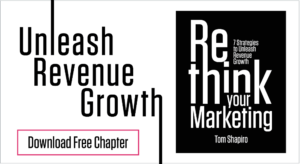Using Neuroscience to Optimize the Customer Acquisition Process

Anna Kendrick. Alec Baldwin. Reshma Saujani. Serena Williams. Angela Duckworth. Michael Strahan. These were just some of the speakers at INBOUND 2016 in Boston.
It was a thrill to be at a conference with these overachievers. It was just as much a thrill and an honor to give my own presentation to a packed audience at INBOUND. My talk focused on the topic of: “Using Neuroscience to Optimize the Customer Acquisition Process”. Here is a quick summary of my talk, which was not as funny as Anna Kendrick’s, but it did reference candy sushi for what it’s worth…
THE BRAIN
The human brain contains roughly 100 billion neurons, creating trillions and trillions of synapses. On a per-weight basis, humans boast more neurons in the brain than any other species. All of this power is actually up to 30X more powerful than the world’s most powerful supercomputer. As marketers, it behooves us to understand as much as possible about the mind of our audience in order to connect more directly and engage more deeply.
DEVIATION & SURPRISE
We are bombarded with 3,000 – 5,000 marketing messages daily. This doesn’t even include social media. We are faced with information overload, and this puts a tremendous strain on our brains to figure out what to pay attention to and what to ignore. With so much noise all around us, our minds automatically turn off and dismiss much of the marketing that’s targeting us. The threshold for grabbing one’s attention has never been higher.
On top of this, the human mind wanders about 30% of the time on average, according to Susan Weinschenk. And that’s a conservative number.
Face it, the cards are stacked against your brand.
Your brand therefore needs to cut through all the noise and capture the attention of your audience if you hope for brand success. The way to do that is through deviation or surprise. According to studies by the neuroscientist Gregory Berns and his team, the human brain is programmed to enjoy surprise. We actually enjoy surprises more than what we like. As our brains are inundated with input, and with much of it boring or codified, your brand will have more success by going against the grain, breaking from convention, and surprising your audience with the unexpected.
EMOTIONS
The neuroscientist Antonio Damasio conducted studies on people with damage to the part of the brain that triggers emotions. In other words, these folks could not feel emotions. What he found was that they had an extremely difficult time making decisions, including any type of purchase decision. It’s with this in mind that you need to realize that if your brand is not evoking an emotional response from your audience, you’re making it mentally and physically challenging for them to buy from you.
Studies have shown that emotional advertising on TV outperforms rational advertising by a factor of 3-to-1 in terms of purchase intent, with print advertising demonstrating a factor of 2-to-1.
Google and CEB conducted a study of B2B firms and found that emotional messaging has twice the impact as non-emotional messaging, and that purchase intent declines if emotional messaging is reduced during the purchase cycle.
Make ’em feel something!
VISION
We see with our brains. Our brains process visuals 60,000X faster than text, according to 3M. Roughly half of the brain’s resources are devoted to our vision system. Over time, 60% of our auditory genes have been damaged, as the evolutionary fight is resulting in a far more vision-oriented human being.
The Pictorial Superiority Effect (PSE) means that the more visual the input, the more we recognize and recall the information. We remember roughly 10% of the text we read 72 hours later, but add visuals to it and we remember 65%.
The power of vision is proven nowhere more powerfully than in a story in John Medina’s Brain Rules. In the book, Medina points to a study conducted in the world’s epicenter of wine country, Bordeaux, France. It was there that 54 of the world’s most accomplished sommeliers were handed what looked to be a glass of red wine. Only, it was actually white wine with odorless red dye. The only difference between the before-and-after was the color.
The sommeliers were then asked to describe the wine. You might expect a few of the wine tasters to incorrectly describe the wine as red wine. The reality is that all 54 thought it was red wine. Not one got it right. That’s the power of vision to control our thoughts.
With this in mind, review your current marketing, presentations, and assets. Are they too text-heavy? How can you make your brand more visual so that you can communicate more effectively with your audience?
SOCIAL PROOF
The Harvard Business Review lists Robert Cialdini’s Influence: The Psychology of Persuasion, Revised Edition in “Breakthrough Ideas for Today’s Business Agenda.” Fortune Magazine lists Influence in its “75 Smartest Business Books.” It’s with this background in mind that I looked at one of the main principles in Cialdini’s research during the INBOUND talk, the principle of social proof in wielding influence on others.
https://www.youtube.com/watch?v=njf3qPR1Vvc&t=14s
Do you like canned laughter when watching TV sitcoms? You hate it? Same here. In fact, I would guess that almost everyone dislikes canned laughter.
If that’s the case, though, then why do TV executives insist on using it? Cialdini points out that it’s because canned laughter triggers something in our brains that makes us want to laugh and to feel it’s perfectly acceptable to laugh. In fact, we not only laugh along with the canned laughter, but we laugh louder and we laugh longer.
Social proof is powerful in influencing your behavior towards a brand, product or service. You can point to the number of existing customers your business already has, or to the number of Twitter followers your brand has, or to the percentage of dentists that recommend your toothpaste, etc. It’s all effective.
When thinking about social proof, you do not need a celebrity endorsement. Consider this. According to BrightLocal, 88% of people trust online reviews as much as recommendations from family and friends. And according to Ambassador, 91% of B2B buyers are influenced by WOM (Word Of Mouth) in the decision making process. This is all the proof you may need to start taking social proof more seriously in your marketing.
PRICING & THE BRAIN
Research findings by professors at the University of Richmond and Clark University published in the Journal of Consumer Psychology reveal that the brain believes that a price is actually more affordable or more expensive in just the presentation of the number itself. For example, the price $1,000.00 could be written as $1,000.00, $1,000, $1000.00, $1000 or $1K. The shorter the display of the number, the more affordable it is perceived, even though all of the actual numbers are exactly the same. If you are selling a luxury item, you may want to communicate a higher price. If you are trying to convince a prospective customer that your price is affordable, then you may want to shave off the number of digits you display, for example, showing $1000 instead of $1,000.00.
When I was working at Panasonic in Tokyo, one of the pricing strategies used by the company was to always add a higher priced option with any new release. In other words, if a new product was priced at $500, then a second, premium version of the product would be priced at $600 or $700. Very few sales were made of the higher priced item, but this pricing strategy anchored the consumer into thinking that the lower priced item was inexpensive and that they were “saving” lots of money.
So when working on improving the bottom of your marketing funnel, look at pricing strategies to help your audience feel more comfortable in breaking out the wallet for your offering.
SUMMARY
The quick recap of my INBOUND presentation above provides a snapshot of some of the main topics of the talk, but it should steer you in the right direction for achieving more significant results with your customer acquisition process. Using neuroscience, you can improve your marketing to generate more leads and customers. Whether the top of the funnel or the bottom, basing your initiatives on neuroscientific principles amplifies the effectiveness of all of your marketing.
The INBOUND audience was fantastic, and I extend a huge “THANK YOU” to everyone in attendance. Hope to see you at future events!
